1994 CHEVROLET S10 service
[x] Cancel search: servicePage 3 of 340
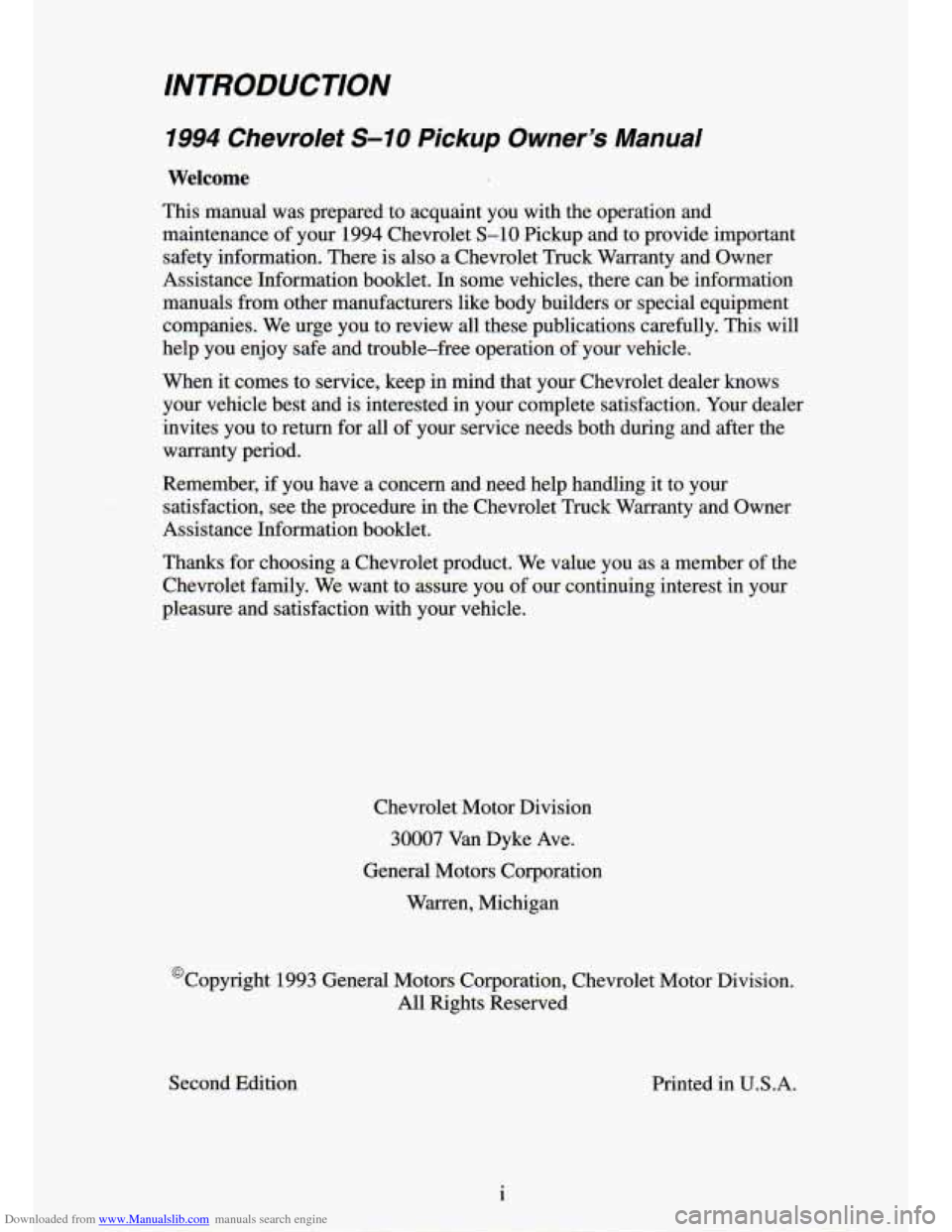
Downloaded from www.Manualslib.com manuals search engine INTRODUCTION
1994 Chevrolet S-IO Pickup Owner's Manual
Welcome
This manual was prepared to acquaint you with the operation and
maintenance of your 1994 Chevrolet S-10 Pickup and to provide important
safety information. There is
also a Chevrolet Truck Warranty and Owner
Assistance Information booklet.
In some vehicles, there can be information
manuals from other manufacturers like body builders or special equipment
companies. We urge you to review all these publications carefully. This will
help you enjoy safe and trouble-free operation
of your vehicle.
When it comes to service, keep in mind that your Chevrolet dealer knows
your vehicle best and is interested in your complete satisfaction. Your dealer
invites you to return for all
of your service needs both during and after the
warranty period.
Remember,
if you have a concern and need help handling it to your
satisfaction, see the procedure in the Chevrolet Truck Warranty and Owner
Assistance Information booklet.
Thanks for choosing a Chevrolet product. We value you as a member
of the
Chevrolet family. We want to assure you of our continuing interest
in your
pleasure and satisfaction with your vehicle.
Chevrolet Motor Division 30007 Van Dyke Ave.
General Motors Corporation Warren, Michigan
'Copyright 1993 General Motors Corporation, Chevrolet Motor Division.
All Rights Reserved
Second Edition Printed in
U.S.A.
i
Page 4 of 340
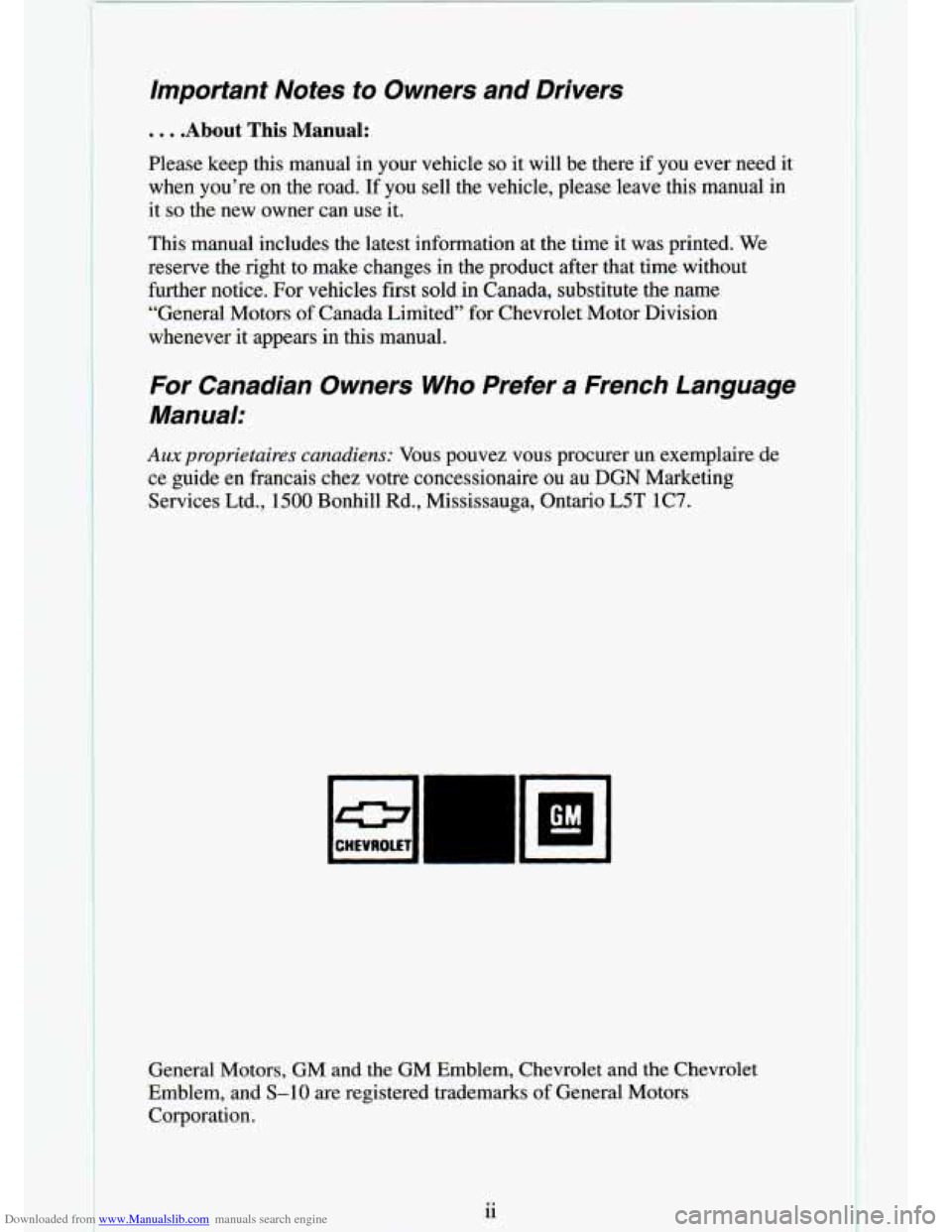
Downloaded from www.Manualslib.com manuals search engine Important Notes to Owners and Drivers
. . . .About This Manual:
Please keep this manual in your vehicle so it will be there if you ever need it
when you’re on the road. If you sell the vehicle, please leave this manual in
it so the new owner can use it.
This manual includes the latest information at the time it was printed. We
reserve the right to make changes in
the product after that time without
further notice. For vehicles first sold in Canada, substitute the name
“General Motors of Canada Limited”
for Chevrolet Motor Division
whenever it appears in this manual.
For Canadian Owners Who Prefer a French Language
Manual:
Aux proprietaires canadiens: Vous pouvez vous procurer un exemplaire de
ce guide en francais chez votre concessionaire ou au
DGN Marketing
Services Ltd., 1500 Bonhill
Rd., Mississauga, Ontario L5T 1C7.
.. .
General Motors, GM and the GM Emblem, Chevrolet and the Chevrolet
Emblem, and
S-10 are registered trademarks of General Motors
Corporation.
Page 6 of 340
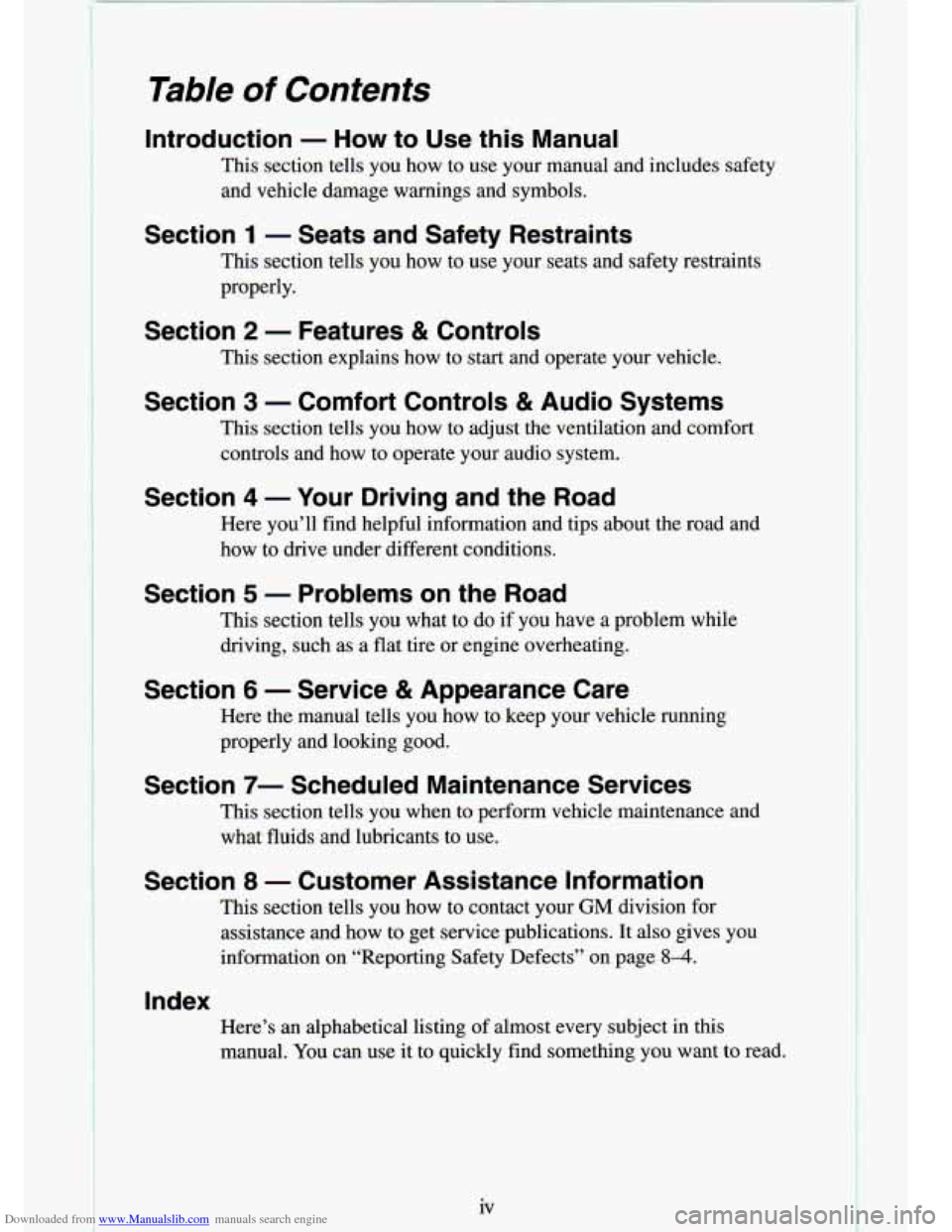
Downloaded from www.Manualslib.com manuals search engine Table of Contents
Introduction - How to Use this Manual
This section tells you how to use your manual and includes sa\
fety and vehicle damage warnings and symbols.
Section 1 - Seats and Safety Restraints
This section tells you how to use your seats and safety restraints
properly.
Section 2 - Features & Controls
This section explains how to start and operate your vehicle.
Section 3 - Comfort Controls & Audio Systems
This section tells you how to adjust the ventilation and comfo\
rt controls and how to operate your audio system.
Section 4 - Your Driving and the Road
Here you’ll find helpful information and tips about the road\
and
how to drive under different conditions.
Section 5 - Problems on the Road
This section tells you what to do if you have a problem while
driving, such as a flat tire
or engine overheating.
Section 6 - Service & Appearance Care
Here the manual tells you how to keep your vehicle running
properly and looking good.
Section 7- Scheduled Maintenance Services
This section tells you when to perform vehicle maintenance and
what fluids and lubricants to use.
Section 8 - Customer Assistance Information
This section tells you how to contact your GM division for
assistance and how
to get service publications. It also gives you
information on “Reporting Safety Defects” on page
8-4.
Index
Here’s an alphabetical listing of almost every subject in this
manual. You can use it to quickly find something you want
to read.
Page 7 of 340
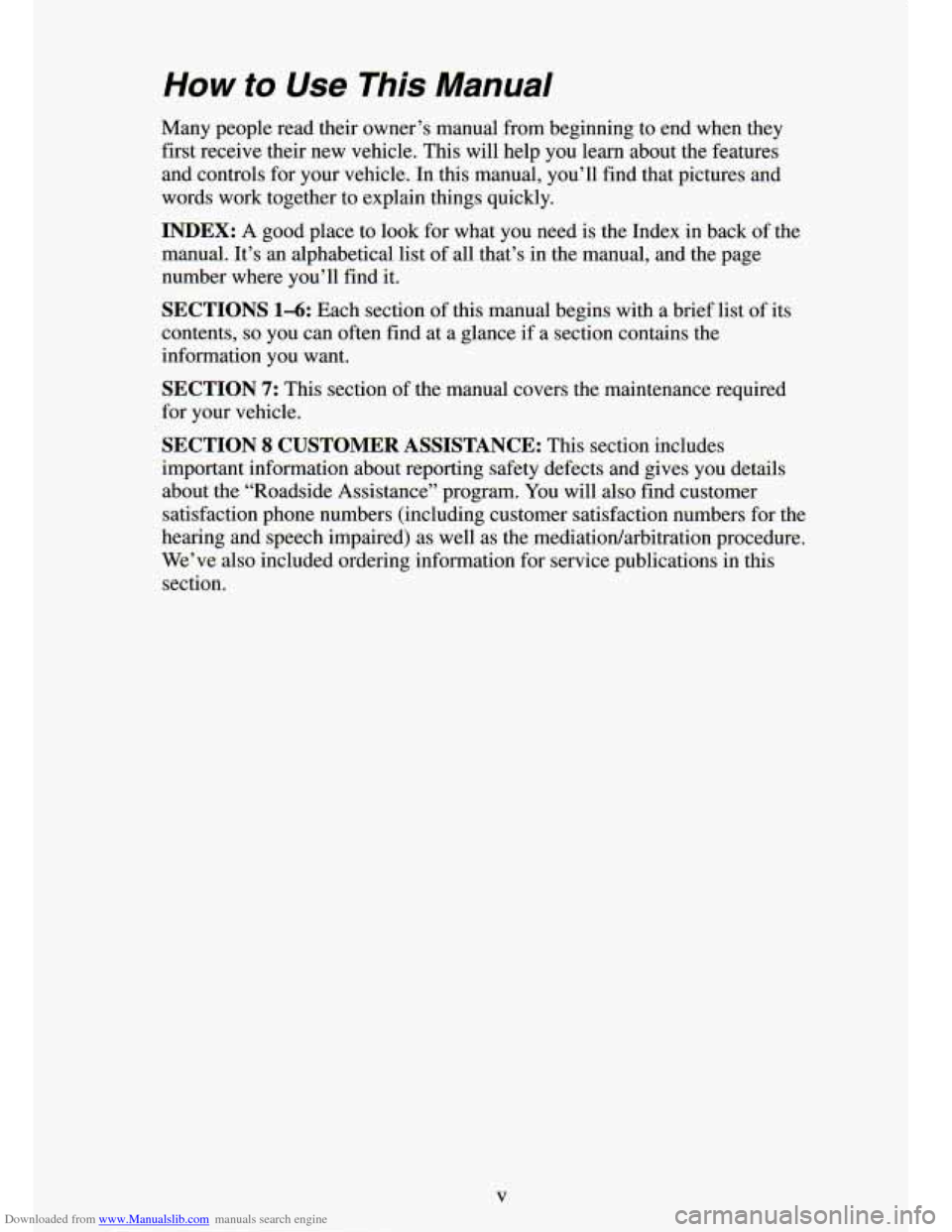
Downloaded from www.Manualslib.com manuals search engine How to Use This Manual
Many people read their owner’s manual from beginning to end when they
first receive their new vehicle.
This will help you learn about the features
and controls for your vehicle.
In this manual, you’ll find that pictures and
words work together to explain things quickly.
INDEX: A good place to look for what you need is the Index in back of the
manual. It’s an alphabetical list of all that’s in the manual, and the page
number where you’ll find it.
SECTIONS 1-6: Each section of this manual begins with a brief list of its
contents,
so you can often find at a glance if a section contains the
information you want.
SECTION 7: This section of the manual covers the maintenance required
for your vehicle.
SECTION 8 CUSTOMER ASSISTANCE: This section includes
important information about reporting safety defects and gives you details
about the “Roadside Assistance” program. You will also find customer
satisfaction phone numbers (including customer satisfaction numbe\
rs for the
hearing and speech impaired) as well as the mediatiodarbitration procedure.
We’ve also included ordering information for service publications
in this
section.
V
Page 57 of 340
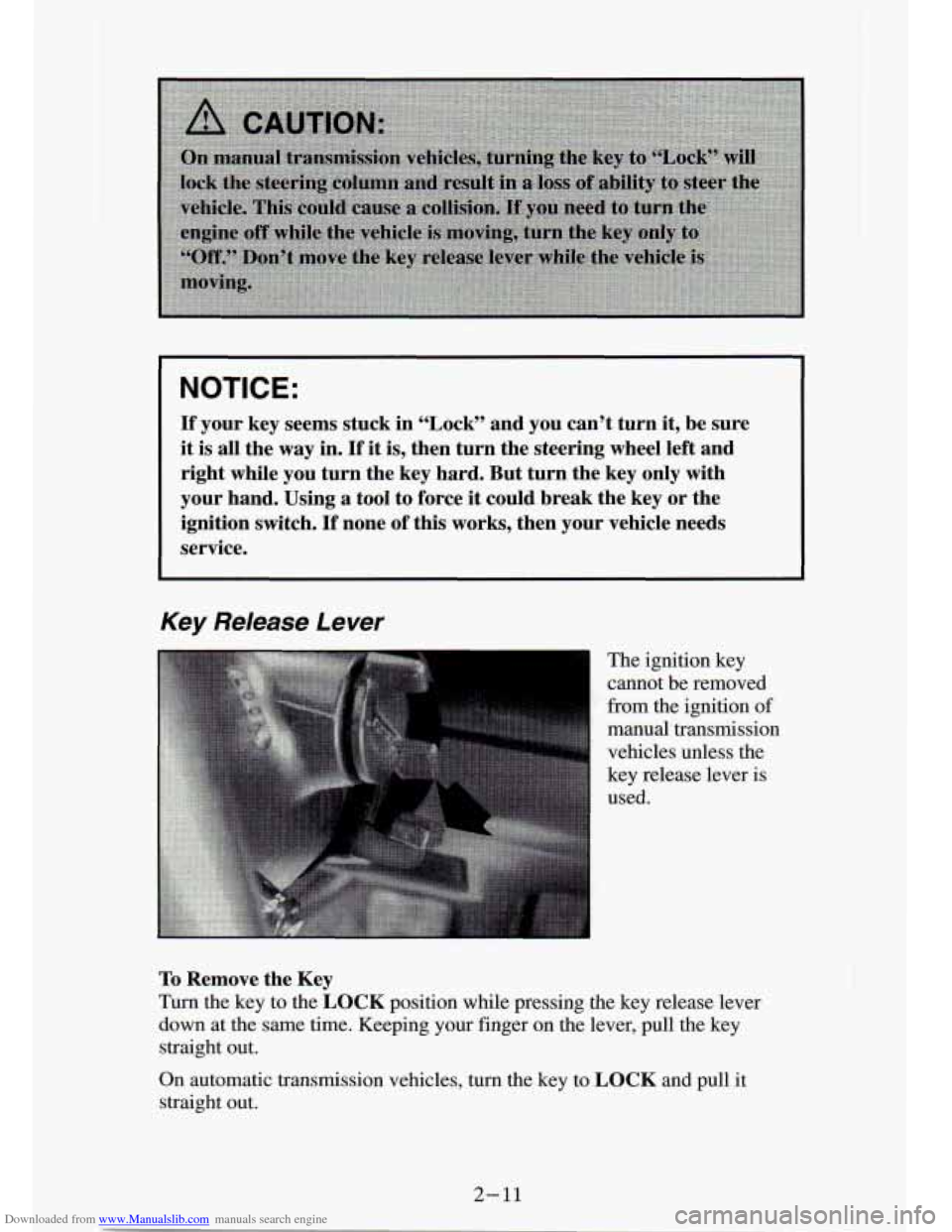
Downloaded from www.Manualslib.com manuals search engine NOTICE:
If your key seems stuck in “Lockyy and you can’t turn it, be sure
it is all the
way in. If it is, then turn the steering wheel Ieft and
right while you turn the key hard. But turn the key only with
your hand. Using a tool to force it could break the key or the
ignition switch.
If none of this works, then your vehide needs
service.
Key Release Lever
The ignition key
cannot be removed
from the ignition of
manual transmission
vehwles unless the
key release lever is
used.
To Remove the Key
Turn the key to the LOCK position while pressing the key release lever
down at the same time. Keeping your finger on the lever, pull the key
On automatic transmission vehicles, turn the key to LOCK and pull it
straight out.
straight out.
2- 11
Page 75 of 340
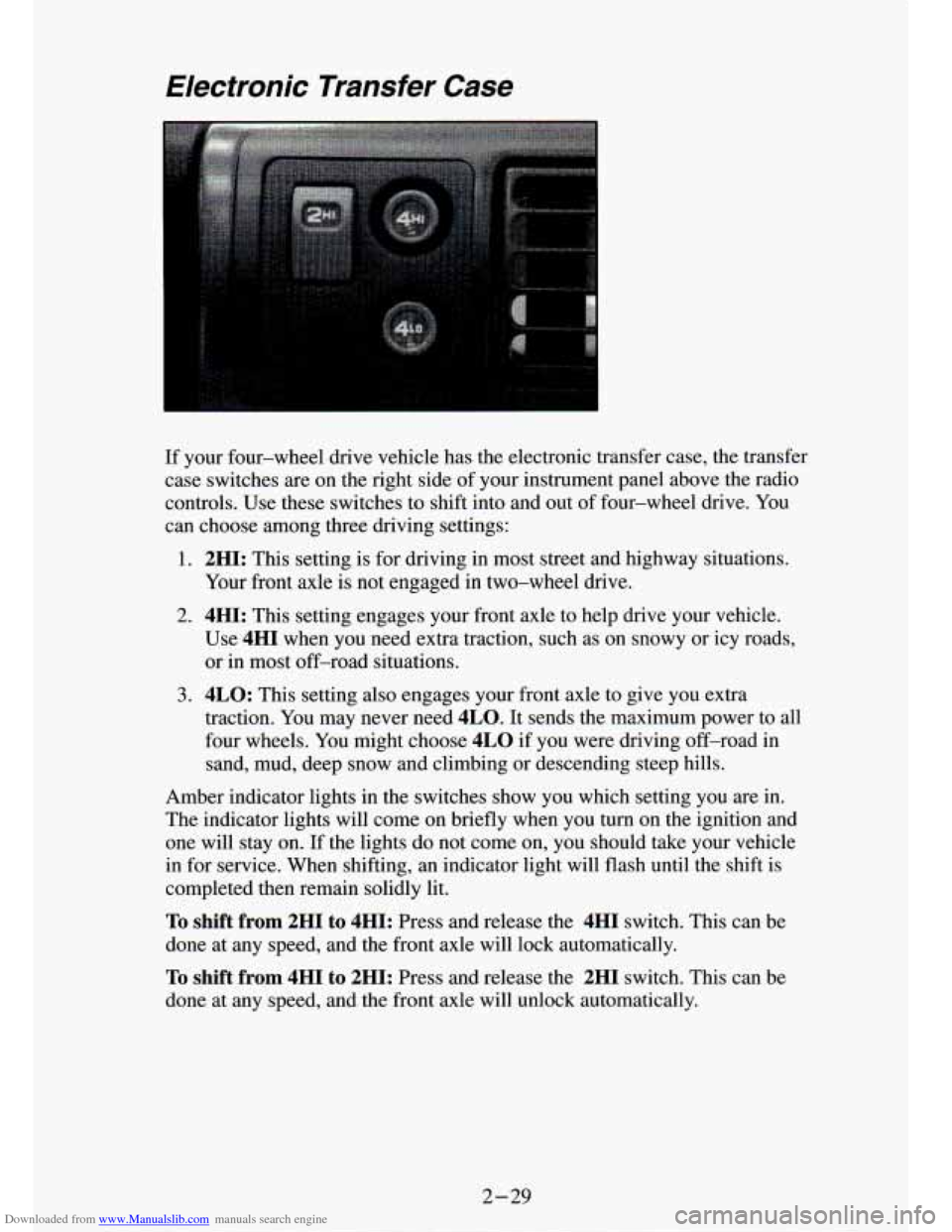
Downloaded from www.Manualslib.com manuals search engine Electronic Transfer Case
If your four-wheel drive vehicle has the electronic transfer case, the transfer
case switches are on the right side of your instrument panel above the radio
controls. Use these switches to shift into and out of four-wheel drive. You
can choose among three driving settings:
1. 2HI: This setting is for driving in most street and highway situations.
Your front axle is not engaged
in two-wheel drive.
2. 4HI: This setting engages your front axle to help drive your vehicle.
Use
4HI when you need extra traction, such as on snowy or icy roads, \
or in most off-road situations.
3. 4LO: This setting also engages your front axle to give you extra
traction. You may never need
4LO. It sends the maximum power to all
four wheels. You might choose
4LO if you were driving off-road in
sand, mud, deep snow and climbing or descending steep hills.
Amber indicator lights in the switches show you which setting \
you are in.
The indicator lights will come on briefly when you
turn on the ignition and
one
will stay on. If the lights do not come on, you should take your vehicle
in for service. When shifting, an indicator light will flash until the shift is
completed then remain solidly lit.
To shift from 2HI to 4HI: Press and release the 4HI switch. This can be
done at any speed, and the front axle will lock automatically.
To shift from 4HI to 2HI: Press and release the 2HI switch. This can be
done at any speed, and the front axle will unlock
; omaticallv.
2-29
Page 76 of 340
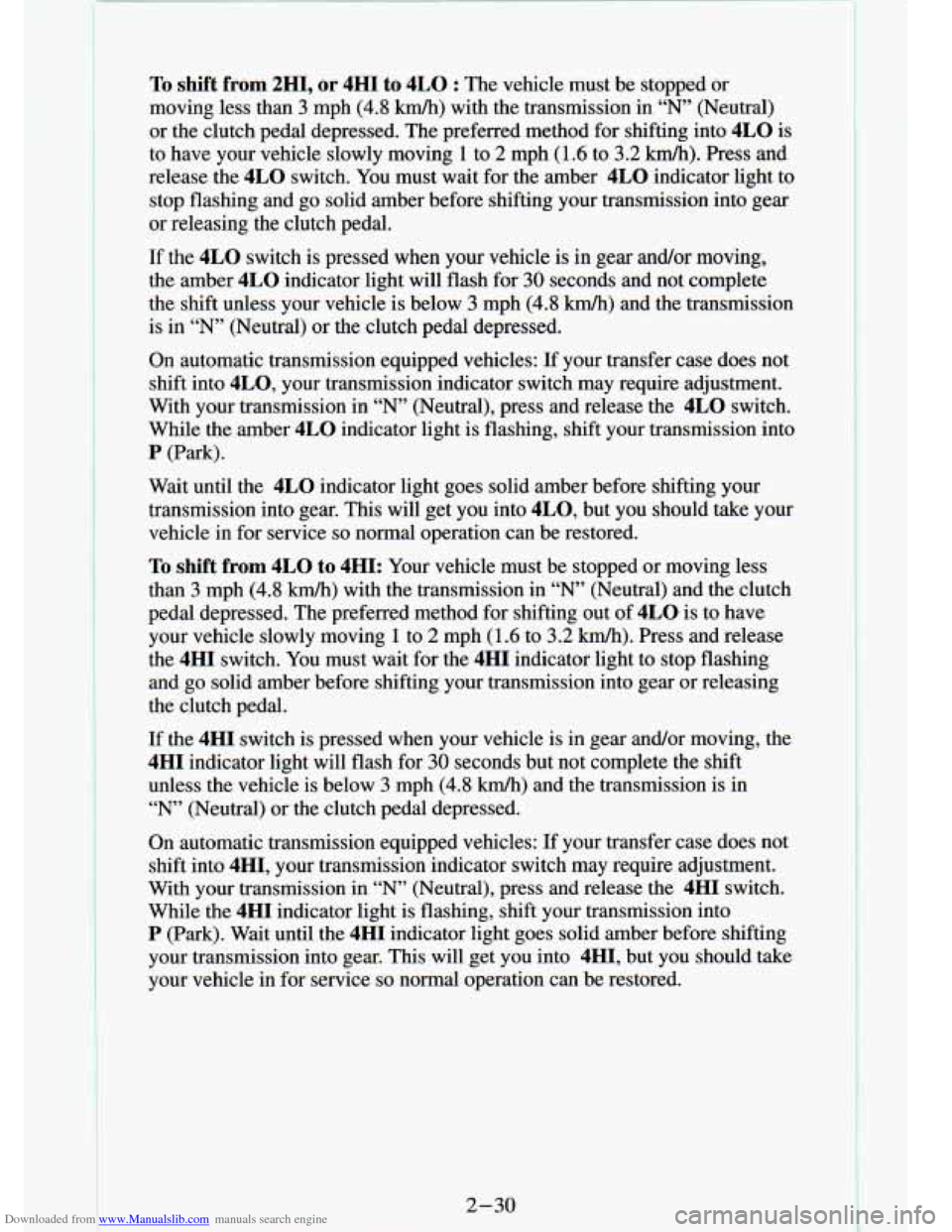
Downloaded from www.Manualslib.com manuals search engine To shift from 2H1, or 4HI to 4LO : The vehicle must be stopped or
moving less than
3 rnph (4.8 km/h) with the transmission in “N” (Neutral)
or the clutch pedal depressed. The preferred method for shifting into
4LO is
to have your vehicle slowly moving
1 to 2 mph (1.6 to 3.2 ludh). Press and
release the
4LO switch. You must wait for the amber 4LO indicator light to
stop flashing and go solid amber before shifting your transmission into
gear
or releasing the clutch pedal.
If the
4LO switch is pressed when your vehicle is in gear and/or moving, \
the amber
4LO indicator light will flash for 30 seconds and not complete
the shift unless your vehicle is below
3 mph (4.8 km/h) and the transmission
is in “N” (Neutral)
or the clutch pedal depressed.
On automatic transmission equipped vehicles: If your transfer case does not
shift into
4L0, your transmission indicator switch may require adjustment.
With your transmission in
“N’ (Neutral), press and release the 4LO switch.
While the amber
4LO indicator light is flashing, shift your transmission into
P (Park).
Wait until the
4LO indicator light go - - solid amber before shifting your
transmission into gear. This will get
you into 4L0, but you should take your
vehicle in for service
so normal operation can be restored.
To shift from 4LO to 4HI: Your vehicle must be stopped or moving less
than
3 mph (4.8 km/h) with the transmission in “N” (Neutral) and the clutch
pedal depressed. The preferred method for shifting out of
4LO is to have
your vehicle slowly moving
1 to 2 mph (1.6 to 3.2 km/h). Press and release
the
4HI switch. You must wait for the 4HI indicator light to stop flashing
and
go solid amber before shifting your transmission into gear or rele\
asing
the clutch pedal.
If the
4HI switch is pressed when your vehicle is in gear and/or moving, the
4HI indicator light will flash for 30 seconds but not complete the shift
unless the vehicle is below
3 mph (4.8 km/h) and the transmission is in
“N’ (Neutral) or the clutch pedal depressed.
On automatic transmission equipped vehicles: If your transfer case does not
shift into
4H1, your transmission indicator switch may require adjustment.
With your transmission in
“N’ (Neutral), press and release the 4HI switch.
While the
4HI indicator light is flashing, shift your transmission into
P (Park). Wait until the 4HI indicator light goes solid amber before shifting
your transmission into gear. This will get you into
4H1, but you should take
your vehicle in for service
so normal operation can be restored.
2-30-
I
Page 105 of 340
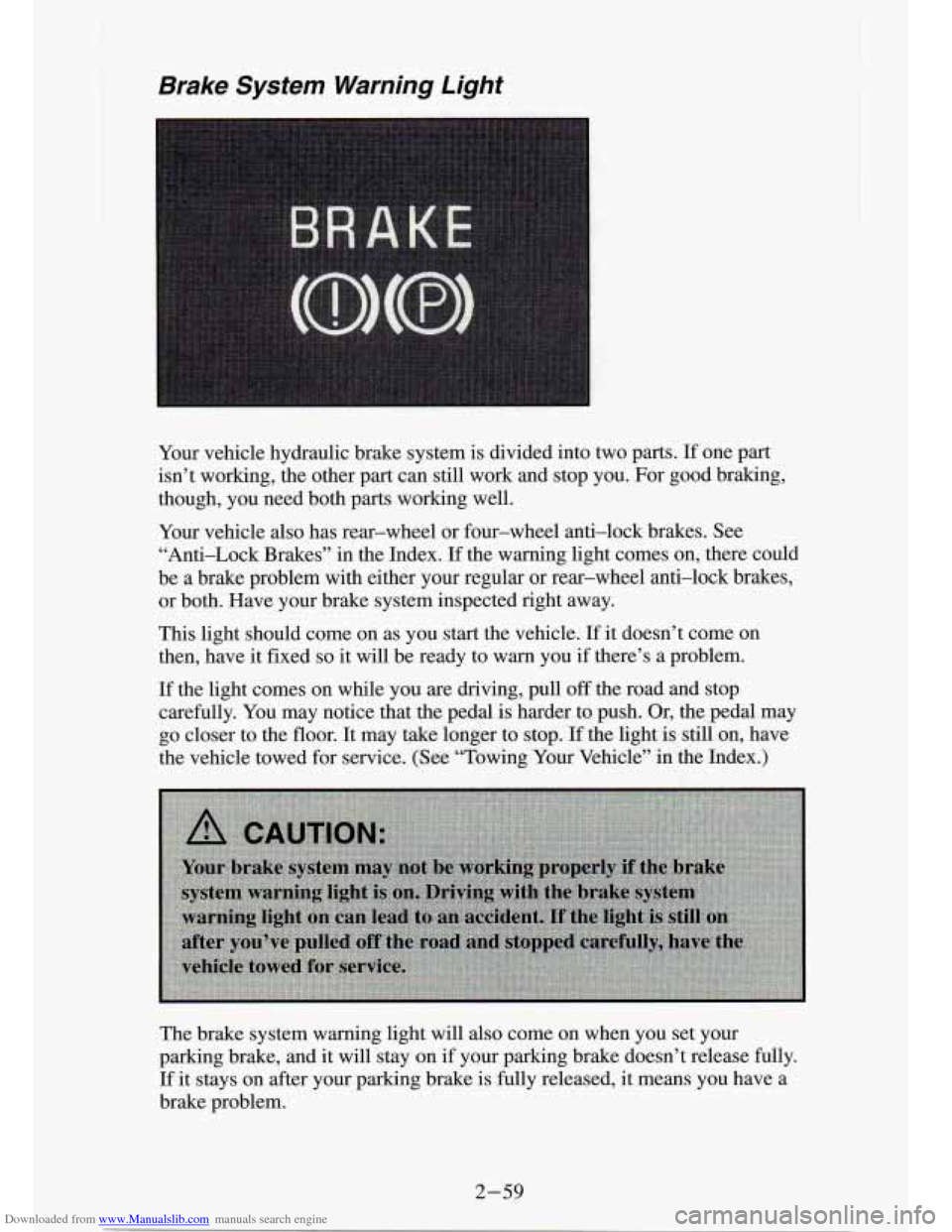
Downloaded from www.Manualslib.com manuals search engine Brake System Warning Light
Your vehicle hydraulic brake system is divided into two parts. If one part
isn’t working, the other part can still work and stop you. For good braking,
though, you need both parts working well.
Your vehicle also has rear-wheel or four-wheel anti-lock brakes. See \
“Anti-Lock Brakes” in the Index.
If the warning light comes on, there could
be a brake problem with either your regular or rear-wheel anti\
-lock brakes, or both. Have your brake system inspected right away.
This light should come on as you start the vehicle.
If it doesn’t come on
then, have it fixed
so it will be ready to warn you if there’s a problem.
If the light comes on while you are driving, pull off the road and stop
carefully. You may notice that the pedal
is harder to push. Or, the pedal may
go closer to the floor. It may take longer to stop.
If the light is still on, have
the vehicle towed for service. (See “Towing Your Vehicle” in the Index.)
The brake system warning light
will also come on when you set your
parking brake, and it will stay on
if your parking brake doesn’t release fully.
If it stays on after your parking brake is fully released, it means you have a
brake problem.
2-59